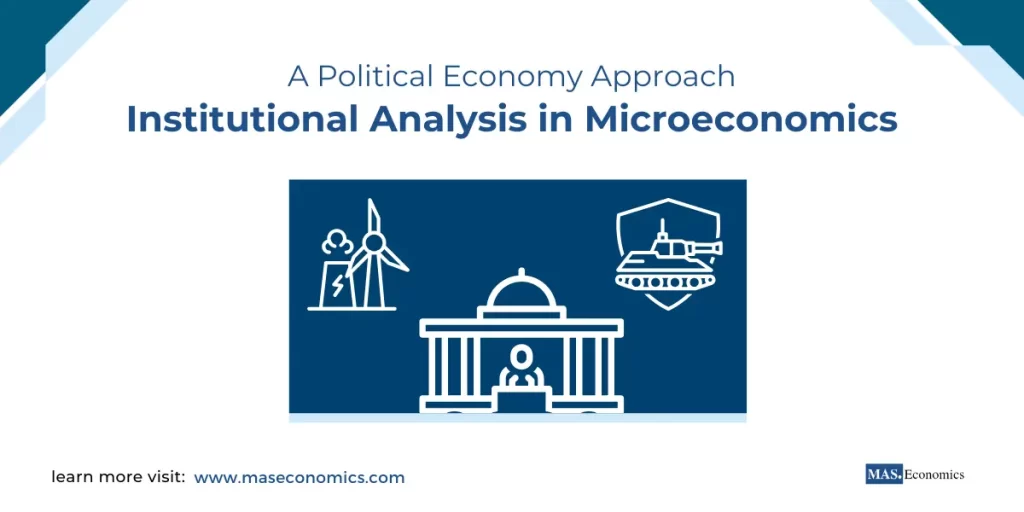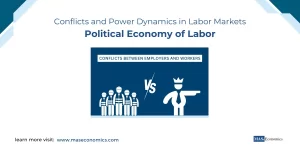Microeconomics examines individual decision-making and its impact on markets. To truly understand these decisions, it’s crucial to consider the institutions that shape the behavior of firms and consumers. Institutional analysis in microeconomics, viewed through a political economy lens, moves beyond traditional assumptions and raises broader questions about power, social norms, and institutional influences on economic activity.
What Is Institutional Analysis in Microeconomics?
Institutional analysis in microeconomics focuses on understanding how institutions—the rules, norms, and customs governing economic behavior—impact the allocation of resources. This approach emphasizes that economic decisions do not happen in a vacuum; instead, they are influenced by social and political forces that determine which choices are available and which behaviors are incentivized.
In mainstream economics, decision-making is often presented as an abstract concept: consumers maximize utility, firms maximize profit, and markets function toward equilibrium. However, institutional analysis challenges this simplification. It asks questions like: Who sets the rules of the market? Who benefits from the current regulatory structure? How do culture, history, and politics shape consumer preferences and business operations?
The Political Economy Perspective
In mainstream microeconomic theory, individuals are modeled as rational agents who make decisions to maximize their satisfaction or profit. However, this ignores the significant influence of institutions, including the government, social norms, legal frameworks, and market structures, on shaping behavior. Political economy, as a field, expands the scope of microeconomic inquiry by considering how institutions emerge, evolve, and impact economic outcomes.
Formal vs. Informal Institutions
To start, institutions can be categorized into formal and informal types. Formal institutions include laws, regulations, contracts, and policies that govern how individuals and firms operate. Examples are antitrust laws that prevent monopolistic practices, labor laws that protect workers’ rights, and tax policies that influence business decisions. These formal frameworks dictate the permissible scope of economic behavior and significantly impact market structures.
On the other hand, informal institutions consist of societal norms, traditions, and values that shape economic decisions in less overt ways. For instance, consumer behavior in a given culture might be influenced by social norms, such as expectations about conspicuous consumption or collective family spending. Firms may adjust their practices to accommodate these norms, showing that the informal rules of society are just as influential as formal regulations.
How Institutions Affect Microeconomic Behavior
Example: Labor Markets and Power Structures
In mainstream microeconomics, wages are determined by the intersection of supply and demand for labor. Yet, institutional analysis reveals a much more complex picture. Wage negotiations do not occur solely based on market dynamics; they are also determined by the bargaining power of workers and firms, which, in turn, depends on labor laws, union regulations, and collective bargaining institutions.
For example, in countries where unions are strong and collective bargaining is institutionalized, workers may secure higher wages and better working conditions. This bargaining power shifts the labor supply curve in ways that mainstream models may fail to capture accurately. Therefore, institutional influences directly impact wage levels, worker satisfaction, and overall economic productivity.
Example: Defense Spending and Resource Allocation
Political economists are particularly interested in the role that institutional power structures play in resource allocation decisions. Take the example of U.S. government spending on the F-35 combat aircraft, which costs $1.7 trillion despite ongoing performance issues and crashes. Mainstream economic analysis might view this as a cost-benefit decision focused on national defense. However, from an institutional analysis perspective, this decision reflects the influence of the military-industrial complex—an alliance between the defense industry and government that shapes budget allocations.
The institutional factors influencing defense spending include political contributions from defense contractors, the influence of lobbyists, and cultural attitudes towards national security. These factors create a situation where spending on education or healthcare is deprioritized compared to defense, not because of economic efficiency, but because of entrenched power structures. Political economists argue that institutions like the military-industrial complex are central to understanding why certain economic choices are made over others.
Institutions and Market Structures
The political economy perspective also gives us deeper insights into different market structures. For instance, monopolies and oligopolies do not simply arise due to economies of scale or barriers to entry—they are often the result of institutional factors. Regulatory capture, where large corporations influence policy decisions to create favorable market conditions, is an example of how institutions shape market structures. This is particularly evident in industries like telecommunications, pharmaceuticals, and energy, where large firms often have the lobbying power to influence regulatory standards.
These institutional forces help explain why some industries tend to become concentrated despite apparent competition, while others remain competitive. They highlight the need to scrutinize not just market outcomes but also the institutional mechanisms that enable or constrain competition.
The Role of Culture and Conspicuous Consumption
Another aspect that political economists focus on is culture. Cultural institutions significantly shape consumer preferences and behavior. For example, Thorstein Veblen, a key figure in institutional economics, coined the term “conspicuous consumption” to describe how individuals buy goods not merely for their utility but to display wealth and status. This cultural drive leads to resource allocation that prioritizes luxury goods over basic needs, which can result in inefficiencies and inequalities in the distribution of resources.
In wealthy societies, conspicuous consumption can lead to the overproduction of luxury goods while basic needs may be underfunded or overlooked. Cultural norms that drive consumerism thus become powerful institutions influencing the market in ways that go beyond the supply and demand dynamics traditionally considered by microeconomists.
Critiques of Mainstream Economic Models
Institutional analysis also provides a critique of mainstream economic models, such as the production possibilities curve (PPC). The PPC is used to show the trade-offs involved in allocating resources between different goods. While useful in illustrating the concept of opportunity cost, the PPC assumes that resources are fully and efficiently employed. Political economists argue that this assumption is often unrealistic, especially in the presence of underemployment and institutional constraints.
For example, mainstream economics might assume that labor can be freely allocated between industries. However, institutional analysis shows that labor mobility is restricted by factors like education, skill requirements, and regional immobility. These are institutional barriers that prevent workers from moving from declining sectors, such as manufacturing, to growing sectors like technology.
The Importance of Government and Policy
In institutional analysis, the government is viewed as a regulator and a crucial actor in shaping market outcomes through policy decisions. For example, governments may promote specific industries through subsidies, tax breaks, or direct investment, influencing resource allocation within an economy. Government policy becomes a defining institutional force that molds market dynamics by deciding which sectors to support and how to regulate markets.
Consider the example of the renewable energy sector. In many countries, the growth of renewable energy has been spurred by government policies like subsidies for solar panel installations or tax incentives for electric vehicles. These formal institutions create a market environment in which investing in renewable energy becomes more attractive, changing the behavior of firms and altering the resource allocation within the economy.
Similarly, political economy analysis pays attention to power dynamics. Policies are often influenced by powerful interest groups, and this influence impacts economic outcomes. Who benefits from a particular policy is a crucial question that institutional analysis attempts to answer. For instance, tax reforms may be structured in a way that benefits certain industries or high-income groups, reflecting institutional biases that mainstream microeconomic models might overlook.
Conclusion
Institutional analysis in microeconomics expands our understanding of markets by considering the influence of social norms, regulations, and power dynamics on economic behavior. Unlike mainstream perspectives that often ignore institutional context, this approach highlights the critical role institutions play in shaping resource allocation and market outcomes.
This perspective reveals why markets do not always behave predictably, as traditional models suggest. Economic decisions are not made in isolation; they are shaped by a network of institutions, from governments to cultural norms, which influence the opportunities and constraints faced by economic actors.
FAQs:
What is institutional analysis in microeconomics?
Institutional analysis studies how formal rules, social norms, and political structures shape economic behavior and influence market outcomes.
How does the political economy approach differ from traditional microeconomics?
The political economy approach considers power dynamics, institutional influences, and societal norms, unlike traditional microeconomics, which assumes rational decision-making in isolation.
What are formal and informal institutions, and how do they affect markets?
Formal institutions include laws and policies, while informal institutions consist of norms and traditions. Both influence market behavior by shaping incentives, constraints, and decision-making processes.
How do institutions impact labor markets?
Labor market outcomes, such as wages and working conditions, are influenced by institutions like unions, labor laws, and collective bargaining frameworks, which alter the balance of power between workers and employers.
How does institutional analysis explain government spending priorities?
Institutional analysis highlights how political power structures and lobbying shape spending decisions, such as prioritizing defense over education, reflecting entrenched interests rather than economic efficiency.
Why is culture important in understanding consumer behavior?
Cultural norms influence consumer preferences, such as the tendency toward conspicuous consumption, which drives demand for luxury goods and affects market dynamics.
How do institutions influence the formation of monopolies and oligopolies?
Regulatory frameworks and lobbying efforts often enable monopolies or oligopolies by favoring dominant firms, restricting competition, and shaping market structures.
What are the limitations of mainstream microeconomic models?
Traditional models often overlook institutional constraints, such as labor immobility and regulatory barriers, which prevent optimal resource allocation and market efficiency.
How do government policies shape market outcomes?
Policies like subsidies, tax incentives, and regulations act as institutional tools that influence resource allocation, market competition, and industry growth.
Why is institutional analysis essential in microeconomics?
It provides a comprehensive understanding of markets by addressing the role of institutions and social norms, offering insights into complex economic realities that traditional models may miss.
Thanks for reading! Share this with friends and spread the knowledge if you found it helpful.
Happy learning with MASEconomics




